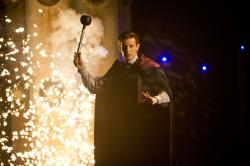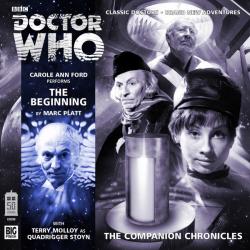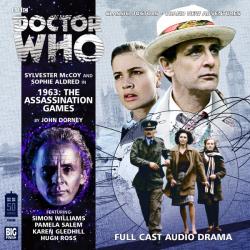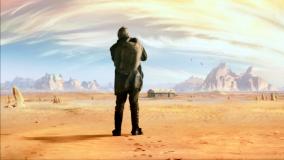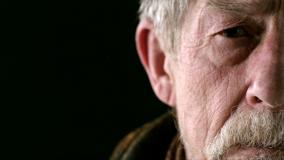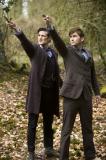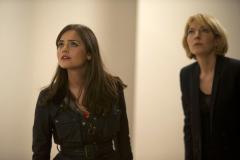Over a week has gone by since
The Day of the Doctor was simulcast around the world and screened simultaneously in cinemas before enjoying a further limited theatrical release of surely unanticipated success. The madness in which Doctor Who 'took over television', earning jibes from satirists which they once reserved for
John Barrowman, has passed. The general medium-term implications and consequences of the way the fiftieth anniversary of Doctor Who was marked are still taking shape, but The Day of the Doctor contended that the episode presented a paradigmatic shift in content as well as in distribution.
It's tempting to say that The Day of the Doctor was a soufflé of a story, expansively frothy with fan-pleasing references, self-aware retroactive continuity, ironically-realised old monsters, and actors doing familiar turns. Instead it was more of a meringue - a solid enough pudding, not over-egged, and densely stuffed with sweetmeats to suit a variety of palates.
The density of the episode's construction is revealed in the opening scene. What looks like a homage to one particular point in the series' history moment turns into the first use of arranging references as part of the foundations for Doctor Who's revised manifesto. The policeman leads the audience past I.M. Foreman's sign, towards Coal Hill Secondary School, before the camera reminds us that our involvement is at its grace and that we are on the other side of the screen from our characters. In a shot more powerful in 3D than in 2D, Clara's hand impresses on the screen and us the much-quoted sentence from Marcus Aurelius's Meditations: 'Waste no more time arguing what a good man should be', leaving out the injunction 'Be one'. Summoned by her Doctor to the TARDIS, Clara nonchalantly says she's not taught anything good, and the Doctor says he hasn't learned anything; but this story completes an arc of the Doctor's moral re-education begun in 2005 and echoing fan readings of the first two seasons of Doctor Who, in which Ian and Barbara teach the Doctor to turn his abilities outwards towards helping people.
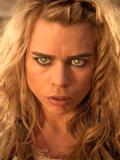
Clara's hand is mirror-writing to us, and Doctor Who is a mirror of our own universe. Here it is a mirror of our own (presumed) experience of Doctor Who. Classrooms and galleries and televisions are our TARDISes. Clara's classroom even has a 4:3 ratio television on the wall, a modern echo of the original TARDIS set. For Clara to leave Coal Hill at 5.16pm she is presumably supervising an after-school club or in-school homework, or else the clock is as broken as the TARDIS's navigation system appeared to be in the 1960s. I[an] Chesterton is the chairman of the board of governors - perhaps this is who appointed Clara or makes sure that no questions are asked about her sudden disappearances from work. The Cwmdare Road location provides the Cardiff-as-London familiarity of latterday Who. The street bears some resemblance to that where Clive lived in Rose, leading those so minded to wonder whether Clive was staking out Coal Hill eight years ago, but also foreshadowing the return of
Billie Piper as the Moment-Rose. Clara's biking and outfit bridge the 1960s of mods and rockers (arguably as much a media confection as Doctor Who) and the present day; but recall previous uses of motorcycles in Doctor Who, most recently contemporary Clara's introductory episode, The Bells of Saint John, but also (given the ride into the TARDIS) the 1996 TV Movie which The Day of the Doctor's distrib counterblasts by challenging Hollywood dominance of cinema and television rather than seeking to be assimilated by it. The Doctor is reading a book on quantum mechanics jacketed in an approximation of the old livery of the 'Teach Yourself' book series, but bearing the imprint of the TARDIS's police box shell. The implication that the ship is attempting to teach the Doctor recalls the relationship between Time Lord and ship in The Doctor's Wife.
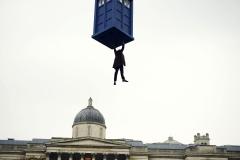
The opening scenes continue to revisit beginnings. The start of Doctor Who and the introduction of Clara are followed by a reprise of the eleventh Doctor's first episode's pre-credits sequence, the gangly
Matt Smith again hanging from the TARDIS prop but this time with the mechanics showing. Instead of one redhead, Amelia Pond, he lands at the behest of another, Elizabeth I of England, and instead of a private domestic garden, the TARDIS is brought down in a public commemorative square used for entertainment and national and local ceremonial. It's right that the adventure should begin there, given the claims this episode makes for Doctor Who as part of British or English national mythology, but the setting also marks one of the episode's jumps between modes of presentation, as a scene led by CGI, greenscreen and mechanical special effects merges seamlessly with one which comes close to being a recorded performance of live theatre. There can be no attempt to hide the crowds in Trafalgar Square watching Matt Smith's descent clinging to the undercarriage of a police box and so they are incorporated into the scene with a reference to illusionist Derren Brown as provider of a cover story, one of the references to contemporary real-life personalities more frequent when Russell T Davies was showrunner than now. Illusion, though, is also a theme of the episode, where even the ravens at the Tower of London are artificial, part of a tourist-heritage setting which conceals a future-facing bastion of planetary defence. Likewise, Doctor Who seems here to be looking backwards to its earlier history, but is celebrating its recent success as a consolidator of large and broad audiences as much as anything.

Reacquainting the audience with the Doctor's past is also a reminder of the post-2005 series' advertising of its emotional literacy, widely regarded as part of its audience-unifying appeal. The renewal of interest in the Time War is aimed as much as those who might not have watched since
David Tennant left in The End of Time as at committed viewers. The introduction of the painting 'Gallifrey Falls'/'No More' through another demonstration of 3D isn't merely a gimmick but a way of emphasising Doctor Who's interruption of the mundane with the otherworldly as well as representing the multi-dimensional nature of the war itself. The painting is one of the few effects designed for 3D which is almost as impressive in 2D; it's designed for the illusion of depth and the added texture of 3D was a bonus.
The painting also chimes with this episode's invocation of memory. The Day of the Doctor knows that viewers will watch to see their recollections of past adventures flattered, and exploits this in ways that seek to surprise. One of these is the much-trailed appearance of
John Hurt's War Doctor; another is the removal of the veil on the appearance of Billie Piper as the interface of the Moment, both figuratively and explicitly recalling Rose's transformation into the Bad Wolf. This manifestation is also a memory, Billie Piper's performance and the editing choices of the decision-makers behind the camera making the flippant 'I always get those two (past and future) mixed up' absolutely credible without provoking even a sympathetic snigger. The use of rapid cutting as the Moment found her new personality has been used before in Doctor Who in a similar situation, the post-regeneration orientation of Matt Smith's Doctor. It's refreshing to have Billie Piper back in a new role which borrows within the narrative from her previous one; but it also celebrates how the programme has benefited from performers and others seizing the opportunities it's presented to transform their careers. Indeed, the reintroduction of Clara in her classroom recalls not only An Unearthly Child but also the earlier career of
Jenna-Louise Coleman playing a schoolgirl in Waterloo Road; Clara's reappearance as a teacher could be interpreted in terms of the move of the actress who plays her to a post-juvenile professional identity as Jenna Coleman.
The hut in the desert to which the War Doctor brings the Moment is intriguing as a playing space. The depiction of a vast conflict through the reactions of a few participants or observers in a small space is an old device. The restrained use of music in the hut scenes allows The Day of the Doctor to again echo as-live performance and recall the ancient conventions of the programme's former homes in west London. The hut is more than just a studio or theatrical stage; it becomes a camera obscura which can not only capture and project the image of distant environments, but make those projected environments real. Despite the War Doctor's attempt to escape the judgement of the TARDIS, the hut is a TARDIS-substitute and the Rose-Moment, as in-narrative director of the hut scenes, even places the crucial 'big red button' front central as if it were the TARDIS console. The hut becomes an analogy not just for the TARDIS, but for the programme. Doctor Who's title character once insisted he was only an observer, but soon developed a habit of becoming involved in things. All three principal Doctors here try at some stage to limit their exposure and their moral ambition, but when they hide in the hut, the universe comes to them and demands they recognise the choices beyond the limits they have defined.
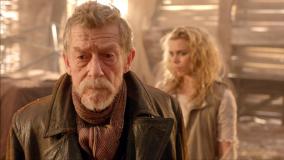
The War Doctor goes to the hut to make an end, but there are clues scattered throughout its design that it is a place of beginnings. After his long trudge through a scorched desert, the Doctor's feet rest on dry straw and a few fresh green leaves. Agricultural implements sit in corners. It's one of many deceptively simple set designs from Michael Pickwoad. The place of destruction is introduced subtly as one of cultivation.
The Day of the Doctor benefits from such skilful use of rhetorical devices, though they are sometimes glib. Moments of crisis are always prefigured by less portentous parallels. The sequence where the three Doctors believe themselves trapped within the Tower dungeon leads them first to look inward, though it is the War Doctor, relatively unburdened by guilt, who provides the pseudo-scientific solution to their captivity. It's Clara, though, who turns up to point out that the door wasn't locked in the first place, just as she later expresses her belief that the Doctor she knows wouldn't have wiped out the Time Lords but would have found another solution. Here she complements the Rose-Moment without interacting with her, as if guided by the patron saint of latterday companiondom.
The appearance of Gallifreyan art in the National Gallery emphasised more directly than ever before Doctor Who's identification of Gallifrey with England/Britain, just as the placing of the TARDIS in Trafalgar Square proposed Doctor Who itself as national commemoration as well as public entertainment. The inclusion of Elizabeth I in the story builds on the identification of the Doctor with the English and British monarchies established by
Steven Moffat in The Beast Below, elaborating two minor sequences in earlier stories by other writers into a scheme by which the Doctor has a close if achronological and irreverent relationship with the royal lineage. Indeed, Elizabeth's letter to the Doctor explicitly dedicates him to England's service.
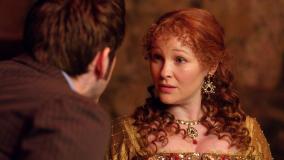
Telegraph.co.uk reviewer Ben Lawrence criticised the casting and performance of
Joanna Page as Elizabeth, but this was unfair and missed what The Day of the Doctor sought to achieve. Page's Elizabeth was woven from several skeins of audience appeal. Her performance accorded with that briefly established by Angela Pleasance in The Shakespeare Code and with the half-told anecdote about Elizabeth's nickname in The End of Time. Casting Page acknowledged latterday Doctor Who's Welshness by drawing from another BBC Wales success of the last decade, Gavin & Stacey. While warmer and more balanced, Page's still capricious Elizabeth owed some of her spirit to Miranda Richardson's Elizabeth of Blackadder II, and probably more than anything (though I'm less familiar with it) to the Elizabeth of Horrible Histories, perhaps the realisation of the last Tudor queen now most current. Elizabeth R and Glenda Jackson's methodical exploration of the queen's character is lost in the remote forgotten traditions of intensely researched BBC history plays, and though still a point of comparison for critics has little contribution to make to modern Doctor Who's playfulness. In any case this Elizabeth was based on all the parts everyone thinks they remember, a kind of '1562 and All That' where the tenth Doctor finds that he was misinformed about Elizabeth's strict adherence to a non-matrimonial policy. In the spirit of the Doctor's perilous journey hanging from the TARDIS, Elizabeth's easy grasp of the TARDIS and implausible skill in impersonating a Zygon is another case where The Day of the Doctor resembles a greatest hits package, building upon Shakespeare's intuition of the non-sixteenth century origins of the Doctor and Martha in The Shakespeare Code and for that matter Henry Avery's grasp of the TARDIS and then of space travel in The Curse of the Black Spot.
The Doctor's marriage to Elizabeth is more than the fulfilment of a tag scene and a throwaway line from earlier episodes. In marrying Elizabeth the Doctor casually marries England and eventually Great Britain given Elizabeth's emblematic immortality in post-Union mythology as patron saint of protestant Britain. In a multi-faith, secular age Doctor Who has provided a sort of national religion, aware of its own fictionality but (most consciously under Russell T Davies) borrowing iconography and language liberally from Christianity. Britain's obsession with its royal family was once compared to Japanese Shinto and the role the Imperial family plays there; it's tempting to compare the Doctor's marriage to Elizabeth to the ritual marriage of the sun goddess to the Japanese Emperor, were it not that the Doctor immediately evades his responsibilities.
Since 2005, UNIT has been tied closely to British symbols too, with its headquarters established at the Tower of London, the English crown's stronghold since Norman times. The Tower of London is explicitly introduced as Kate's office, implying a rough parallel between Kate and Elizabeth I, whose fortress it is. There's a possible echo too of the identification of Kate's father with Arthur in Battlefield, though as someone who has always found the shoehorning of the Doctor into the Merlin archetype problematic it's good here that it is the Time Lord who marries Elizabeth, a virtuous knight as well as a mighty sorcerer; though Elizabeth is some years off from being Spenser's Gloriana, and the audience knows the tenth Doctor will abandon his marital commitments.
In 1562 there are two Elizabeths - human and Zygon. Likewise in the present day there are Zygon copies of Kate and her two junior colleagues. The move from a single monarchical figure to a collective feeds into the episode's theme. Responsibility, to mean something and be capable of change, has to be collective and sufficiently pluralist to accept different points of view. Absolute monarchy, unquestioning military command or self-absorbed withdrawal, whether by human, Zygon or Time Lord, leads to cutting off heads or destroying planets. Discussion without preconceptions leads to solutions. Removing the assumption that genocide (or anything) is inevitable enables everyone to escape from their dungeons, real and metaphorical. The message is one of hope: assuming the worst means that you never know whether to push or pull the door.

The Zygons aren't always served especially well by this script. Monstrous villainy in The Day of the Doctor has a pantomime aspect, with several early Zygon appearances unapologetically calling for cries of 'Look behind you!' accompanied by comedic playing from other cast members. This does make their attack in the undergallery store more frightening, when they threaten and assault and the danger from their touch is made more explicit than in Terror of the Zygons. Jemma Redgrave clearly signposts that she is playing a Zygon by using a subtly lowered tone of voice; the tension nonetheless subsists in Zygon-Kate's scenes with Clara, because Clara has no reason to suspect Zygon involvement. The transformation of Zygon-Kate into Zygon form is pleasingly and disgustingly organic and more consistent with the realisation creatures' technology than the electronic effect used in Terror of the Zygons. Aidan Cook plays the lead Zygon (presumably the deputy commander, Elizabeth's counterpart having been slain by the knife of a king, and a king of England too) as aiming towards the back of the stalls, and a rubbery face following it even without the aid of 3D. Elizabeth I seemed unbothered as she explained that she wasn't a Zygon after all, despite presumably within the hearing range of the Zygons in the pit below.
Several commentators in the past few years have had difficulty with
Steven Moffat's idealisation and emblematisation of women. In Moffat's world, women learn things which men do not, and are beings held in awe. The female companions and disciples of the Doctor represent those who hope and those who learn to turn that hope into action. Clara and the Rose-Moment enable the Doctor to see that the destruction of Gallifrey isn't inevitable. When we meet Osgood, she has not yet understood her potential. She's burdened with asthma and a history of being bullied. She's a grown-up child dressing as the fourth Doctor, with a history many of the writers and fans of 'old' Doctor Who could empathise with as well as many younger members of the present day audience. Following her (out-of-character for plot convenience and unwise) revelation in the gallery, that she knows why the statues have been crushed, she hides in a corner with her eyes closed, praying for the Doctor to save her from the painting-smashing and scenery-chewing Zygons. Instead, realising that she has copied more from the Doctor than his scarf, she saves herself and everyone else, moving afterwards from addressing her superior in deferential tones as 'Ma'am' to the familiar 'Kate', though there will still be room later for one more prayer which confirms her faith. Ingrid Oliver's performance was assured if like others a little broad, but television acting conventions have evolved and diversified from the hard-nosed days of absolute conviction and she still conveyed belief; though I can't have been the only viewer finding it difficult to imagine what a prettier sister might have looked like.
UNIT here move closer than ever to LI'n'DA from Love & Monsters. Thankfully Lee Evans's overacted and misconceived Malcolm from Planet of the Dead is absent except on the other end of a phone, but the unspoken purpose of the Black Archive seems to be a fan-like reconstruction of the Doctor's adventures. Pictures of former companions are joined by string, as if UNIT staff spend their days trying to work out a chronology of the Doctor's adventures and associates. The appearance of Mike Yates in an otherwise very well-known Sara Kingdom photograph must surely inspire a thousand fanfics. We at last see the Space-Time Telegraph referred to in Revenge of the Cybermen and Terror of the Zygons, as if closing a loop between first and second Zygon stories.
Sadly the Black Archive section of the plot fizzled out somewhat. This may be the result of harsh editing and this author's willingness to be misled, but when watching in the cinema, music and performance seemed to suggest wariness and possible betrayal when the two Osgoods shared an inhaler, rather than the conspiratorial reconciliation we were presumably meant to take away and which I could see, eventually, on later viewings. I wanted and expected to return to the Black Archive and see what settlement humans and Zygons achieved; it would have helped maintain the symmetry already established. Perhaps the outcome will be explored in the more Zygoncentric story we seem to have been promised.
Osgood has discovered her own maturity. Doctor Who since 2005 has, one way or another, been about growing up, where it was only intermittently so in the 1963-1989 period. The fourth Doctor asserted that there was no point in being grown-up if you couldn't be childish sometimes, but often maturing was equated with falling in love and getting married, though not always as the end point. (Jo's decision to find adventure and purpose in her trip to Llanfairfach is the point of change, not her marriage to Cliff. Sarah rediscovers childhood wonder, triumphing over cynicism.)
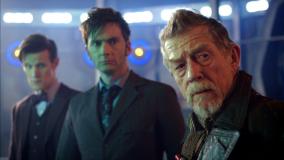
Failing to grow up is an early theme of the War Doctor's conversation with his older/younger selves. The War Doctor has lost his enthusiasm for life and discovery. The first crack in his resolution to use the Moment and end the war comes when the Rose-Moment informs him that if he operates the device, he will survive. Much of the strength of John Hurt's performance comes from his delineation of slow realisation that there is a future to live for, even at great cost. It's an old story, of course - Scrooge has met Christmas Past and Christmas Present and we discover him meeting two unexpected futures. The twist is, here, that the futures aren't especially certain that they deserve to exist. Where the War Doctor rebukes his successors for being ashamed of adulthood, the tenth and eleventh Doctors are ashamed of having been the War Doctor. Throughout, though, the War Doctor is clearly delineated as the Doctor, from his sense of theatre (the carving of 'No More' on the wall at Arcadia, the wish for a big red button) to his relationship with the TARDIS and proprietorship of the Sonic Screwdriver.
Hurt has not played the Doctor before, but his seniority and reputation as an actor are combined with his novelty within Doctor Who to lend authenticity to his running critique of his future - the current programme - from the undercurrents of folk memory. The current Doctors are too youthful; there is too much kissing; the sonic screwdriver is waved about like a weapon when it's a scientific instrument with a specific function. It's tempting to view the saga of the War Doctor as a grumpy old fan reluctant to accept the post-2005 iterations of Doctor Who and slowly reconciled. The occasional appeals to The Three Doctors - probably the most artistically and critically successful previous multi-Doctor anniversary story - recalls Jeremy Bentham's article in Doctor Who Monthly 58, where he argued that Troughton's return had brought many Doctor Who fans of the 1960s who had been alienated by the Doctor's exile to Earth back to the fold. It's surely not an accident that Elizabeth's guard is captained by Lord Bentham, perhaps a fictional forebear of Jeremy. As The Three Doctors built up to a recodification of the series' format, with the Doctor's freedom to travel in time and space formally restored (though it already was in practice), so The Day of the Doctor approaches with greater deliberation the event which has since the series' return, though with varying intensity, defined the Doctor's character and actions.
Before the Moment can be activated the War Doctor has to accept his successors for who they are. The tenth Doctor appears more flippant and less responsible than before. It's unclear whether this 904-year-old Doctor is seen after The Waters of Mars, in denial about his actions and his fate, or in the period between that story and Journey's End. This could allow for the origins of the double portrait of the tenth Doctor and Elizabeth; though given that the portrait bears only a general resemblance to Tennant (though it seemed more precise in 3D) and lacks the precise lines and narrow faces of Elizabethan portraiture, perhaps we are to take it as drawn from Elizabeth's memory, before she turned against the Time Lord king who left and never returned. There's a parallel with The Five Doctors there after all.
One of the ironies of The Day of the Doctor is that the Doctor who has tried hardest to erase himself from the record seeks to save himself - and inadvertently rescues Clara - by inscribing the activation code for Jack Harkness's vortex manipulator on a stone at the Tower of London. In seeking to be forgotten, he's tried also to forget. Instead he has become the version of the Doctor with the greatest number of active friendships, for a while even with a wife and family. He knows how he is shaped by the people who trust him, something with which the tenth Doctor had difficulty. Where the tenth Doctor shaped his friends into his proxies as weapons of war, the eleventh Doctor is himself a weapon, recognised by the Daleks as a predator, by the Cybermen as a battle computer, by the Pandorica coalition and by the Silence as something to be isolated and obliterated to avoid mass destruction. As with his apparent death in The Impossible Astronaut, the Doctor has not been in posession of the full historical record. He is, like the Moment, a weapon with a conscience, but in the Doctor's case that conscience has been misinformed until the last phase of The Day of the Doctor.
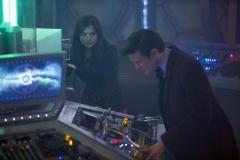
Something like The Day of the Doctor has been evolving in Steven Moffat's imagination for a long time. The idea of the Doctor's name as a promise which his actions can break first took shape in The Beast Below. Those commentators who have noted the greater prominence of children in Moffat scripts and those he has supervised compared to those written or executive-produced by Russell T Davies are vindicated. Though I didn't notice her on screen, the official website reports that there is a small child wearing a multicoloured scarf in the Gallifrey scenes, a direct parallel with Osgood. It's not only on Earth that people hope that the Doctor will save them. There seemed to be no place for children in Davies's Gallifrey, a planet of the deranged and many-times resurrected, inhabited by phantoms from its history devoted to victory at any cost, but Doctor Who is a collaborative enterprise open to reimaginings. Moffat imagines a people who are not necessarily at one with their leaders and so have not descended to the level of the Daleks, supported by a military who are exasperated with and on the verge of revolt against the High Council revealed in The End of Time to be dominated by the ruthless ideology of Rassilon. The Time Lords are successfully recalibrated as sympathetic and worthy of rescue in a way they were not in their previous appearance.
As late as The Night of the Doctor, the idea that there could be a distinction between Daleks and Time Lords in the Time War was dismissed as a delusion which the Doctor clung to as consolation for his losses. His faith in human beings acted as compensation for his inability to stop the Time Lords descending into destructive hatred, but it was constantly challenged and at times - such as in Midnight - overwhelmed. Here, hope in both humans and Gallifreyans is shown to promise vindication after all. It's Clara and the Rose-Moment who steer the Doctor towards the realisation that there is no need to destroy Gallifrey. 'No More' need not mean 'Gallifrey Falls'.
The revision of Doctor Who history here has angered some writers who have argued that the integrity of the
Christopher Eccleston series in particular has been undermined, or that Steven Moffat's writing absolves all characters from the negative consequences of their actions. This isn't so. Gallifrey is still ravaged by war. Arcadia (realised more prosaically than I'd imagined when its fall was first mentioned in
Doomsday) is still a ruin, even though the Dalek conquerors are dead. The people of Gallifrey are left like the Doctor and Susan in An Unearthly Child - cut off without friends or protection, with the aspiration that one day they will return to their own universe. This is a doubtful kind of rescue. Additionally, the fact that neither the War Doctor, the ninth Doctor or the tenth Doctor - or their predecessors - will remember their efforts gives the affair an extra poignancy. Lost in time and with the person who could help them find their way back unable to remember their existence, until The Day of the Doctor the Time Lords might as well be all dead.
The Time Lords might be lost, but their prominence in the story reflects how Doctor Who has been discovered by a worldwide public. In an age of box sets and downloads and streams of various legalities, and just as importantly of numerous reference sites on the internet, backstory is assumed to be much more accessible than it was even when Doctor Who was revived in 2005. The sense of humour expressed by The Day of the Doctor assumes a familiarity with the conventions of the series, even if it isn't what the fandom-literate might recognise. The gag about the 'round things' plays on long-term popular memory without using the 1980s series jargon term 'roundel', though it also maintains the mystery of the TARDIS. The ripple of laughter across the cinema when Kate made her dating protocol joke while requesting the 'Cromer' files confirms the wide dissemination of fan culture at least.
We've seen the end of the tenth Doctor, so here he can only have limited character development. David Tennant's physical appearance is slightly more weathered than it was when he last played the Doctor and it lends emphasis to the nostalgic evidence in his performance. He becomes a caricature of the David Tennant Doctor's image, irresistible to (most) women, emoting but patchily empathic, and suppressing a deep anger with a veneer of nonchalance. At the same time Tennant's timing has if anything improved; his energy is undimmed and the passion in his catchphrases enhanced. These allow for jokes which lightly deconstruct the tenth Doctor's persona: his Mockney accent earns him the label 'Dick Van Dyke', his branded trainers genericised with the archaic regional term 'sandshoes', and Clara's assessment of him is 'nice suit'. At the same time the tenth Doctor's disgust with the eleventh Doctor when he realises his future self has forgotten the number of children alive on Gallifrey at the activation of the Moment jars with what we thought we knew; as the eleventh Doctor says, only partly defusing the awkwardness of the situation, this is what it's like when he talks to himself. The tenth Doctor's departing gag is a gift to local radio quiz hosts everywhere in that the tenth Doctor's last line remains the same, but it also allows him a moment of gravitas. This draws on the reality that David Tennant played the Doctor before Matt Smith and thus enjoys seniority, but that he's playing a younger Doctor who doesn't know the circumstances of his own departure. 'I don't want to go' becomes an almost paternal injunction urging that the eleventh Doctor find a way of avoiding his final death at Trenzalore.
The destruction of Gallifrey is presented as an experience which the Doctor had isolated within his own timeline, the work of an incarnation explicitly created (within and without the narrative) to fight and end the Time War. In contrast the salvation of Gallifrey is the work of every known iteration of the Doctor. It's the act which brings John Hurt's Doctor into the fold. It's one of those moments dubbed fan-pleasing, but it adds, tongue-in-cheek, a unity to Doctor Who which doesn't really exist. John Guilor's lofty and authoritative impersonation of
William Hartnell is all the more trans-temporally spine-tingling because this version of the first Doctor sounds authentic but has lines the historical first Doctor wouldn't have said. Bar Guilor-Hartnell and the interpolated Hurt, all the Doctors up to and including Christopher Eccleston are represented by old clips and sampled dialogue. The determination of all concerned that this story look forward as much as it looks back made the inclusion of Peter Capaldi's Doctor inevitable; the new Doctor remains mysterious, a silent presence marked only by his tense grip on the TARDIS controls and angry, fierce eyes which seemed to fill the air in front of the cinema audience.

In Doctor Who looking forward and looking to the past can end up being the same thing. John Hurt's Doctor's regeneration into the ninth Doctor seemed to use one of the publicity images which dominated billboards across Britain as winter became spring in 2005. The undergallery to which the Doctors return 'Gallifrey Falls' seems to be a different place to that we saw earlier; none of them, nor Clara, note the roundels on the walls. Visual art might be a viewer's TARDIS, but it's been pointed out to me that in The Invasion of Time part of the TARDIS was an art gallery too. Perhaps the undergallery was part of a future TARDIS all the time. Projecting a remote future in which the Doctor once more looks like
Tom Baker is unsurprisingly reassuring to someone guided through their childhood by the fourth Doctor. It's a final grand indulgence, but it works; a sage who talks in riddles but offers hope that even after fifty or twelve hundred years it's far from being all over. One day the Doctor will get back, perhaps (given how hackneyed the quest narrative can be) sooner than we think.
The final image of The Day of the Doctor dovetails narrative with marketing imagery in the form of the montage of Doctors, Hartnell set apart but not assuming the overwhelming prominence he did in some early examples of multi-Doctor fan art such as that which adorned the Doctor Who Appreciation Society's information leaflet in the early 1980s. Especially in the cinema, it appears like a poster image or, with the benefit of 3D, a set of collectable action figures. If so, it's a fitting tribute to Doctor Who as licensing phenomenon, as much as earlier scenes have built upon other aspects of the programme's history. It's not an exposition of that history, nor is that history seen as something to rest upon. The laurels are still to be won and this situation can never change in a medium obsessed with new ideas. Current Doctor Who knows this and The Day of the Doctor is forever puncturing the bubbles of self-congratulation until the end.
Earlier in this review I compared The Day of the Doctor to a meringue. Meringues have spaces in them, and there are gaps in The Day of the Doctor. As previously acknowledged, the UNIT-Zygon plot is left unresolved; the audience never sees whether the Doctor is right to hide the preconceptions of humans and Zygons behind the philosophers' veil of ignorance. It's not clear how the Zygons obtained the Time Lord stasis cube, though perhaps we are to infer that Tom Baker's future Doctor orchestrated this situation in order to guarantee a particular future. Of Doctor Who's creators, C.E. Webber might be proud of this, though Sydney Newman would assuredly have written 'Nuts!' Nevertheless, it's these gaps which have contributed towards Doctor Who because they encourage audience speculation; to extend the meringue metaphor, breaking into a meringue placed over fruit and cream lets those flavours seep into the gaps, and those extra flavours were definitely there. Perhaps dessert comparisons are wrong; all the straw in the hut suggests wholemeal bread was ground there, perfect for soaking up cup-a-soup.
Maybe the contrived food analogies are mistaken. Doctor Who is an edifice of mixed materials, a modern storytelling structure of indefinable something but which has some of the qualities of reinforced concrete. It needs frequent repairs and renewal but survives as long as expert care can be found. There are always going to be gaps in some places because they are essential for absorbing the weight of multiple expectations. On the basis of the manufacture of the anniversary special, The Day of the Doctor is now and then and will also continue to be, so long as those responsible for it understand just where the spaces in Doctor Who should be, and what is needed to keep the rest of the structure resilient and flexible. Transformational moments are part of the process of reconstruction. As the eleventh Doctor says, the Doctor changes history all the time; correspondingly, the historical environment in which Doctor Who is made changes the Doctor. The traumatised soldier seeking to atone for the crimes of war was appropriate for the post-9/11 environment, an adventurer for a West struggling to deal with the myriad complexities of a new geopolitics just as its leaders thought their financial sector might have solved want. With a few years of hindsight, The Day of the Doctor might seem part of popular culture's involvement in the delayed reaction to the 2007 crash, an aspiration to the belief that one can make great leaps of ethical responsibility and principle in a universe where it's difficult to distinguish the merely expedient from the greatest moral good.
